The future of health isn’t about more data—it’s about smarter interpretation that amplifies your natural intelligence.
Note: This article is for educational and informational purposes only. See full disclaimer at the end.
Modern health optimization has created an unexpected paradox: the more we measure, the less we understand.
Consider the typical health-conscious individual today. Multiple devices tracking sleep, readiness, nutrition, glucose, heart rate variability, stress levels, and dozens of other biomarkers. Each system demanding attention, creating digital overwhelm that transforms morning routines into crisis management sessions.
Despite having access to more health data than any generation in history, people report feeling more disconnected from their bodies, not more empowered.
Research from the University of North Carolina revealed that patients using wearable devices to monitor heart conditions like atrial fibrillation were significantly more likely to experience intense fear and anxiety, with one in five patients reporting heightened anxiety in response to irregular rhythm notifications [1].
The technology meant to enhance our biological intelligence often becomes a barrier to it. But there’s an emerging solution that changes everything: true AI partnership that transforms data noise into biological wisdom.
The Problem with Current Health AI
Most people experience health technology as an overwhelming flood of disconnected data points. Your watch knows your heart rate variability, but it doesn’t understand why Monday mornings consistently tank your metrics. Your nutrition app counts calories, but it misses how that evening glass of wine affects your sleep architecture three hours later.
We’ve created sophisticated measurement systems but primitive integration intelligence.
Research from the Cleveland Clinic found that consumer-grade wearables demonstrated variable accuracy in cardiac rehabilitation settings, with some devices showing significant measurement discrepancies during exercise monitoring [2].
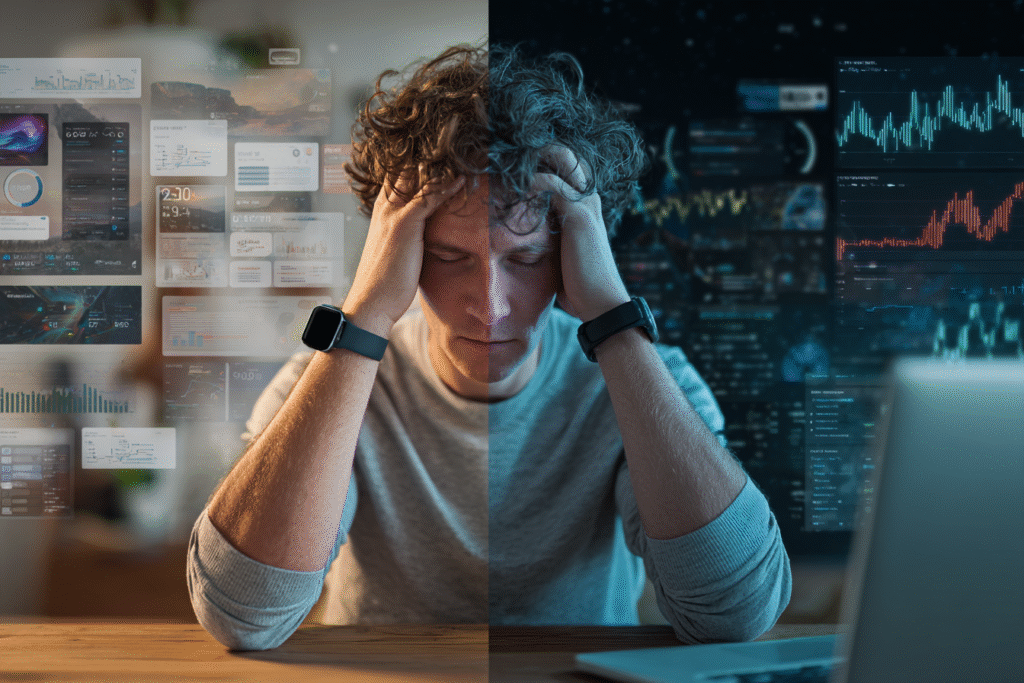
The result is a peculiar form of technological learned helplessness where people become more dependent on external validation while losing touch with their internal biological signals.
What Real AI Health Partnership Looks Like
True AI health partnership isn’t about collecting more data—It’s about transforming data into biological wisdom. It’s the difference between scanning a dashboard of disconnected metrics… and listening to a translator who knows which signals truly matter.
Traditional tracking notices your afternoon energy crashes. AI reveals the underlying pattern: poor sleep architecture, elevated morning cortisol, and environmental triggers combining to create predictable collapses.
The AI doesn’t just identify the pattern—it predicts when the crash will occur based on morning biomarkers and suggests precise interventions timed to biological rhythms. Stable energy emerges not by changing everything, but by optimizing three specific variables at precise moments.
Beyond Reactive to Predictive Intelligence
The transformation from reactive health management to predictive optimization represents a fundamental shift in how we relate to our bodies. Instead of responding to symptoms after they appear, AI partnership enables us to anticipate and prevent dysfunction before it manifests.
AI sees what we can’t.
While you might notice fatigue on certain days, it can trace the cause to invisible variables: stress fluctuations, poor sleep architecture, environmental noise, even nutrient timing.
This level of predictive pattern recognition allows for timely intervention—before dysfunction even begins to manifest.
Dr. Michael Snyder‘s groundbreaking research at Stanford demonstrates how continuous biomonitoring combined with AI analysis can detect illness onset before symptom awareness. His team’s algorithm successfully identified signs of COVID-19 before symptoms arose 63% of the time, detecting illness up to 10 days before symptoms appear [3].
This early detection window creates unprecedented opportunities for preemptive optimization.
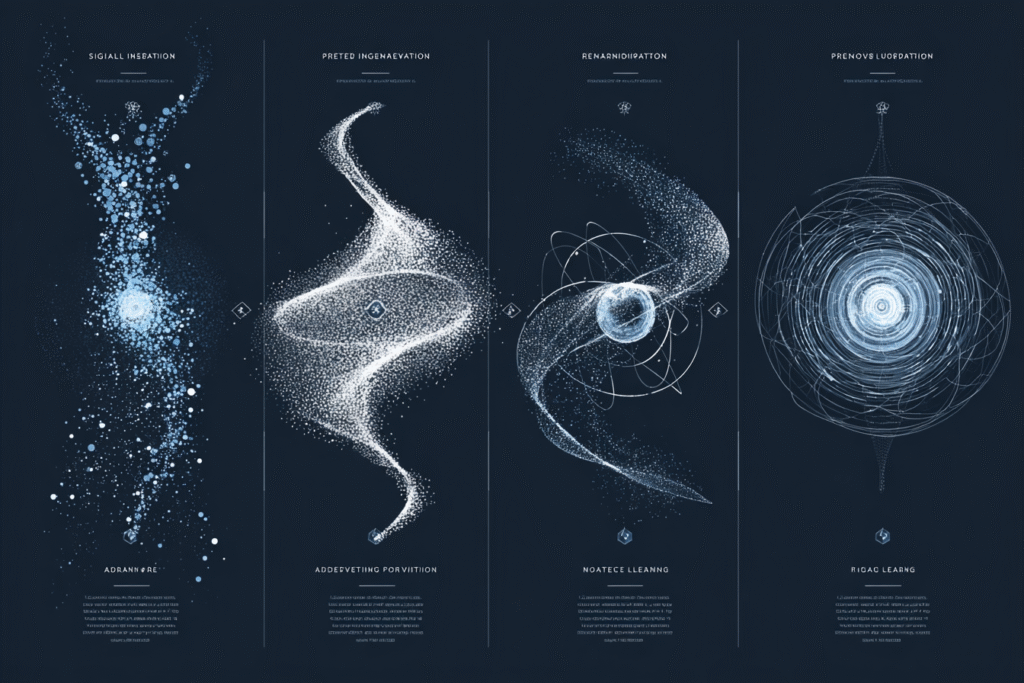
The AI Partnership Protocol
This marks a major milestone in our journey.
Fifty days in, we’re no longer laying the foundation—we’re shifting into empowered co-creation. From here, the insights become more integrated, the tools more powerful, and the clarity more embodied. What follows isn’t just a protocol—it’s a new contract between your biology and your intelligence.
I’m introducing a practical framework that builds on our existing Four Foundational Systems (Sleep Architecture, Stress Response, Nutritional Coherence, Movement Integration) while adding essential AI integration capabilities.
Effective AI health partnership operates through four phases that transform how we interact with health technology.
Each phase builds systematically on the previous, creating a complete intelligence amplification system that evolves with your unique biology.
Phase 1: Signal Integration
Unify fragmented health signals into a coherent biological narrative.
Rather than managing separate data streams, AI synthesis creates unified biological intelligence. Your heart rate variability, sleep architecture, glucose patterns, and stress responses become a coherent narrative about your current state and trajectory.
This integration applies directly to the Four Foundational Systems from Day 48. Instead of optimizing sleep, stress, nutrition, and movement separately, AI reveals how these systems interact in your unique biology. Sleep quality affects stress response, which influences nutritional choices, which impacts movement capacity, creating feedback loops invisible to conscious analysis.
Snyder’s research demonstrates this integration power: his team collected nearly 2 billion measurements from participants, showing how wearable biosensors can detect changes in heart rate, skin temperature, and other measures that correlate with inflammatory markers like C-reactive protein—often before people know they’re getting sick [4].
Phase 2: Pattern Recognition
Identify correlations invisible to the human mind.
AI identifies correlations invisible to human pattern recognition. The connection between environmental factors and physiological responses. The relationship between meal timing and recovery metrics hours later. The impact of specific stressors on autonomic nervous system balance patterns.
Following the SIMPLE framework principles, this pattern recognition focuses on what actually moves the needle rather than getting lost in correlation noise. AI helps distinguish between meaningful patterns that drive health outcomes and interesting but irrelevant correlations.
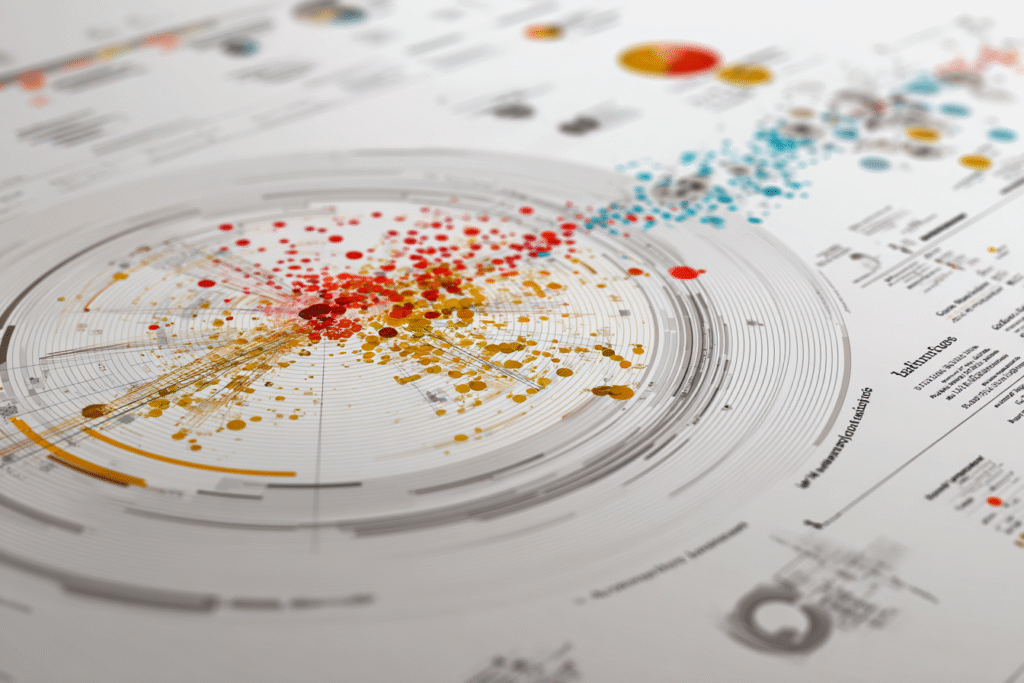
Johns Hopkins research revealed that wearable device data could detect health deterioration through correlations between activity tracker measurements and clinical biomarkers, including NT-proBNP levels that indicate heart failure risk [5].
Once these patterns are identified with precision, the next step transforms recognition into prevention.
Phase 3: Predictive Intervention
Act before dysfunction emerges.
Instead of reacting to problems, AI suggests optimizations before dysfunction occurs. Recommending the right intervention before your stress response peaks. Adjusting recovery protocols based on physiological trajectories. Modifying environment before inflammation ever takes hold.
This predictive capability transforms each of the Four Foundational Systems from reactive to proactive. Sleep interventions happen based on stress patterns from earlier in the day. Nutritional timing adjusts based on predicted metabolic needs. Movement modifications anticipate recovery requirements before fatigue manifests.
Snyder’s team created a tiered alarm system that sends real-time alerts: “Yellow means something’s up, and the person should start sheltering in place. If you get a red alert, that’s basically saying you’re undergoing a significant stress” [6].
Phase 4: Adaptive Learning
Evolve with your biology, season by season.
The system evolves with your biology, recognizing that optimal strategies change with seasons, life circumstances, and physiological adaptation. What works in winter may not work in summer. What optimizes performance during high-stress periods differs from maintenance phases.
This adaptive learning prevents the rigid application of optimization protocols that ignore biological reality. AI learns your personal optimization landscape: which interventions work best for your specific biology, which metrics correlate most strongly with your performance, which environmental modifications create the greatest impact.
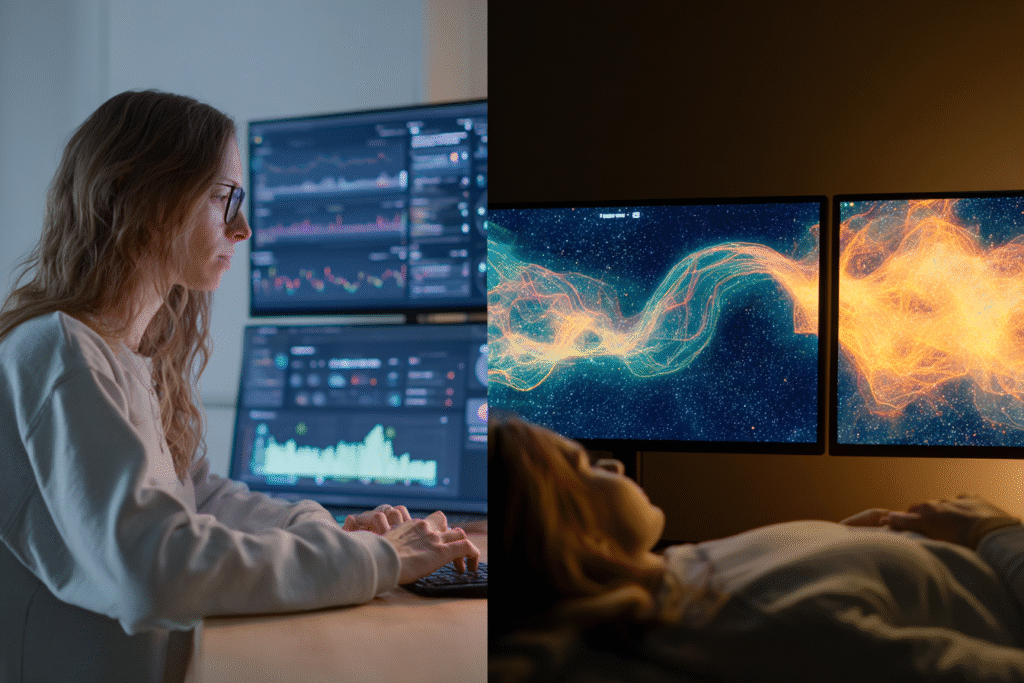
With these four phases in place, we move from technical integration to something deeper: an intelligence partnership rooted in trust, rhythm, and feedback.
The Human-AI Intelligence Amplification Model
The most effective AI health partnership doesn’t replace human intuition—it amplifies it.
Your body constantly sends signals through sensation, energy levels, mood fluctuations, and subtle performance changes. AI helps you decode these signals with precision impossible through conscious analysis alone.
This amplification works bidirectionally. While AI identifies patterns you might miss, your experiential feedback trains the AI to understand your unique responses. The technology learns your personal optimization landscape, but you maintain authority over implementation decisions based on lived experience.
Think of it as biological translation. Your body speaks in the language of sensations, energy fluctuations, and performance changes.
AI provides sophisticated pattern recognition that helps you understand what your body is communicating, but the conversation remains fundamentally between you and your biology.
The Smart Integration Strategy
Converting from data overwhelm to AI partnership requires systematic integration rather than wholesale technology replacement. The following approach has proven effective across diverse optimization goals:
Week 1: Data Audit and Consolidation
Review all current tracking devices and applications. Identify overlapping measurements and data gaps. Select one primary integration platform that can synthesize multiple data streams. Most people discover they’re collecting redundant information while missing critical biomarkers that actually drive their foundational systems.
Apply SIMPLE framework thinking: What data actually correlates with sleep quality, stress resilience, nutritional optimization, and movement capacity?
Eliminate metrics that provide interesting information without actionable insights.

Week 2: Pattern Recognition Training
Enable AI analysis across your consolidated data. Allow the system to identify baseline patterns without making changes. Resist the urge to immediately act on insights. This baseline establishment period creates the foundation for accurate pattern recognition.
Focus specifically on how your Four Foundational Systems interact. How does sleep architecture affect stress response the following day? How do nutritional choices influence movement capacity hours later? How do stress patterns impact sleep quality that night?
Week 3: Predictive Testing
Begin implementing AI suggestions for one specific foundational system. Track both predicted outcomes and actual results. This calibration phase teaches the AI your unique response patterns while building confidence in the system’s accuracy.
Start with the system where you have the most data and the clearest outcome metrics. Sleep optimization often provides the best starting point because sleep architecture changes are measurable and their effects on other systems are typically obvious.
Week 4: Integrated Optimization
Expand AI integration across all Four Foundational Systems. Use predictive insights to prevent rather than react to dysfunction. Develop feedback loops where your experiential observations enhance AI accuracy while AI pattern recognition enhances your biological awareness.

The Technology Philosophy Shift
Effective AI health partnership requires a fundamental shift in how we relate to technology. Instead of viewing devices as external authorities telling us about our bodies, we learn to see them as amplification tools that enhance our natural biological intelligence.
This shift transforms the relationship from dependence to collaboration.
You’re not outsourcing health decisions to algorithms—you’re using AI to access deeper layers of your own biological wisdom.
The difference isn’t subtle—it’s sovereign.
Dependence creates anxiety when technology fails or provides conflicting information. Collaboration creates resilience because the intelligence remains fundamentally yours, simply enhanced by better pattern recognition and predictive capability.
Avoiding the AI Health Traps
Without care, AI health partnership can recreate the very problems it aims to solve.
Over-optimization based on AI suggestions can create new forms of health anxiety. Analysis paralysis can replace action with endless data interpretation.
Technology dependence can atrophy natural body awareness.
Research confirms these concerns. A study from HITLAB found that high-tech wearables can contribute to health data anxiety, with one case study documenting a 70-year-old woman with atrial fibrillation who experienced significant anxiety from 916 electrocardiography recordings in a year, ultimately requiring six sessions of cognitive behavioral therapy to address the anxiety induced by her smartwatch [7].
The antidote is maintaining what I call “biological sovereignty“—the understanding that AI serves your health intelligence rather than replacing it. The most sophisticated algorithm cannot replace your direct experience of energy, vitality, and wellbeing.
Effective AI partnership enhances rather than replaces intuition.
The technology provides data interpretation and pattern recognition while you maintain authority over implementation decisions based on your lived experience.
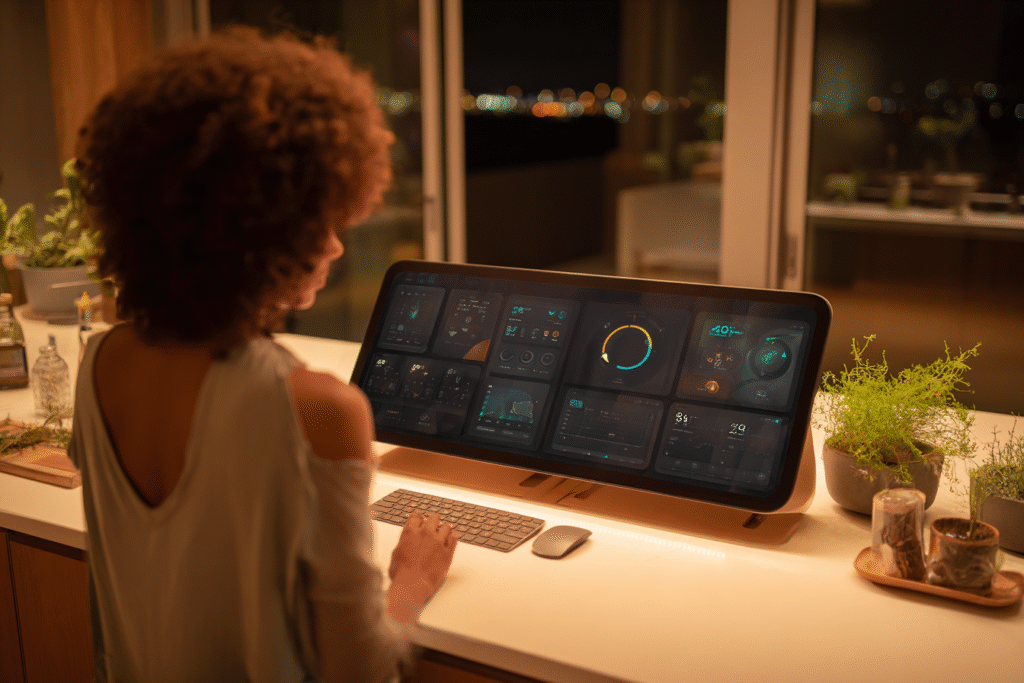
Warning signs that AI partnership has become AI dependence include: checking devices before assessing how you feel, anxiety when devices malfunction, inability to make health decisions without algorithmic input, and prioritizing metrics over experiential feedback.
The Precision Optimization Revolution
When AI health partnership functions optimally, it enables precision optimization impossible through traditional approaches. Instead of following generic protocols, you discover interventions calibrated to your unique biology, lifestyle, and goals.
This precision extends beyond individual optimization to understanding how your health patterns interact with environmental factors, social dynamics, and life circumstances.
AI can predict how travel affects your circadian rhythms, how specific relationships impact your stress responses, how seasonal changes influence your nutritional needs.
The result is health optimization that feels effortless because it aligns with rather than fights against your natural patterns. Instead of forcing your biology to conform to external standards, you discover the specific conditions that allow your natural vitality to flourish.
Creating Sustainable AI Integration
Sustainable AI health partnership requires building systems that enhance rather than complicate your daily experience. The best integration feels invisible—providing insights and suggestions that improve your life without creating additional management burden.
This invisibility emerges when AI learns your preferences, schedule, and decision-making patterns well enough to provide relevant information at optimal moments. Instead of constant notifications demanding attention, you receive precisely timed insights that enhance rather than interrupt your natural rhythms.
The goal isn’t to quantify every aspect of health but to create intelligent feedback loops that support your body’s natural optimization capacity. AI becomes a sophisticated biological translator, helping you understand and respond to your body’s communication with unprecedented clarity.
The Future of Biological Intelligence
AI health partnership represents the beginning of a broader revolution in human optimization.
As technology becomes more sophisticated and integration more seamless, we’ll develop new forms of biological intelligence that combine human intuition with artificial pattern recognition.
This evolution points toward a future where health optimization feels as natural as breathing—supported by invisible AI systems that understand our biological patterns so completely that optimal choices become effortless.
The transformation begins with recognizing that AI isn’t here to replace your health intelligence—it’s here to amplify it beyond what was previously possible.

Your AI Health Partnership Journey
The shift from data overwhelm to AI partnership begins with a simple recognition: your body already contains the intelligence necessary for optimal health. AI’s role is to help you access and act on that intelligence with greater precision and predictive capability.
Start where you are. Choose one of the Four Foundational Systems where you currently feel stuck despite having data. Sleep quality despite tracking sleep. Energy management despite monitoring nutrition. Stress optimization despite measuring heart rate variability. Movement consistency despite fitness tracking.
Apply AI pattern recognition to understand the deeper correlations creating your current patterns. Use predictive insights to intervene before problems manifest. Most importantly, maintain sovereignty over your health decisions while leveraging AI to enhance your natural biological intelligence.
The future of health doesn’t live in dashboards or data dumps — it lives in the subtle, sovereign dance between your biology and your intelligence.
AI doesn’t replace your wisdom. It sharpens it.
And now, for the first time, you have a co-pilot who sees what you feel—and helps you move toward what you truly are.
See you in the next insight.
Comprehensive Medical Disclaimer: The insights, frameworks, and recommendations shared in this article are for educational and informational purposes only. They represent a synthesis of research, technology applications, and personal optimization strategies, not medical advice. Individual health needs vary significantly, and what works for one person may not be appropriate for another. Always consult with qualified healthcare professionals before making any significant changes to your lifestyle, nutrition, exercise routine, supplement regimen, or medical treatments. This content does not replace professional medical diagnosis, treatment, or care. If you have specific health concerns or conditions, seek guidance from licensed healthcare practitioners familiar with your individual circumstances.
References
Rosman, L., et al. (2024). “Wearable Device Use and Clinical Outcomes Among Patients With Atrial Fibrillation.” Journal of the American Heart Association, 13(14). https://news.unchealthcare.org/2024/07/wearable-devices-can-increase-health-anxiety-could-they-adversely-affect-health/
- Etiwy, M., et al. (2019). “Accuracy of wearable heart rate monitors in cardiac rehabilitation.” Cardiovascular Diagnosis and Therapy, 9(3), 262-271. https://pmc.ncbi.nlm.nih.gov/articles/PMC6603497/
Mishra, T., et al. (2020). “Early detection of COVID-19 using a smartwatch.” Nature Biomedical Engineering, 4, 1208–1220. https://med.stanford.edu/news/all-news/2020/12/smartwatch-can-detect-early-signs-of-illness.html
Li, X., et al. (2017). “Digital Health: Tracking Physiomes and Activity Using Wearable Biosensors Reveals Useful Health-Related Information.” PLOS Biology, 15(1). https://med.stanford.edu/news/all-news/2017/01/wearable-sensors-can-tell-when-you-are-getting-sick.html
- Xu, Z. P., et al. (2022). “Wearable Activity Trackers Can Be Used to Determine Health Metrics That Could Support Clinical Care.” npj Digital Medicine, 9, 696. https://www.hopkinsmedicine.org/news/newsroom/news-releases/2022/11/wearable-activity-trackers-can-be-used-to-determine-health-metrics-that-could-support-clinical-care
Snyder, M. (2020). Stanford Medicine COVID-19 Detection Study. https://med.stanford.edu/news/all-news/2020/12/smartwatch-can-detect-early-signs-of-illness.html
HITLAB Research (2024). “Mental Health Balance Pitfalls of Wearables.” https://www.hitlab.org/mental-health-balance-pitfalls-wearables/


